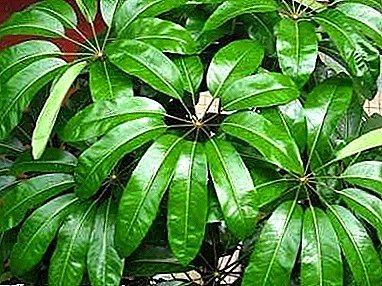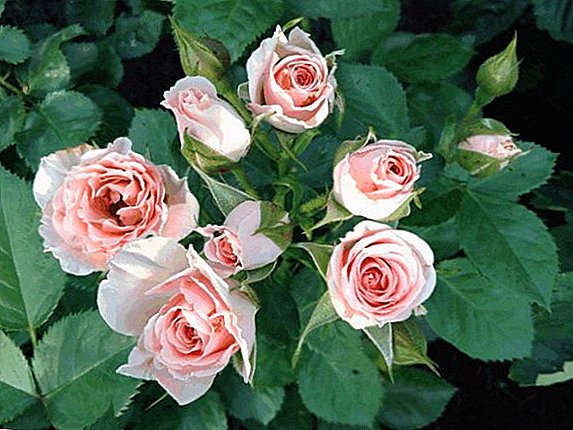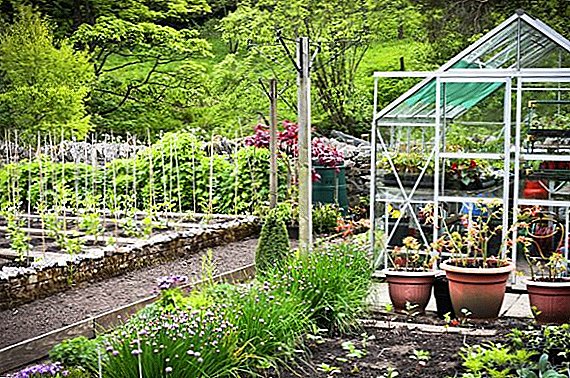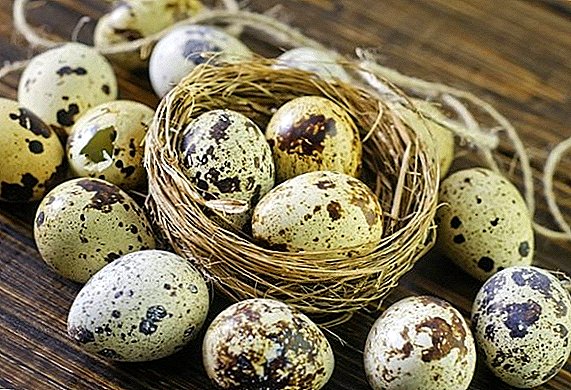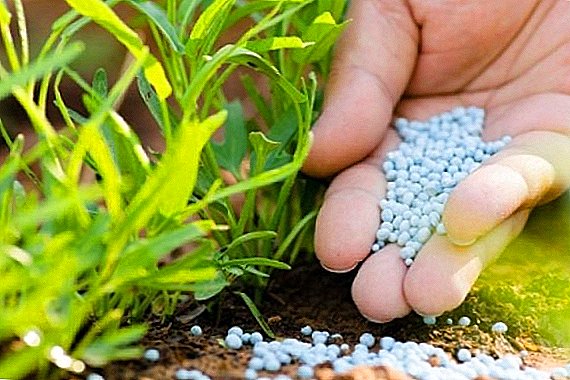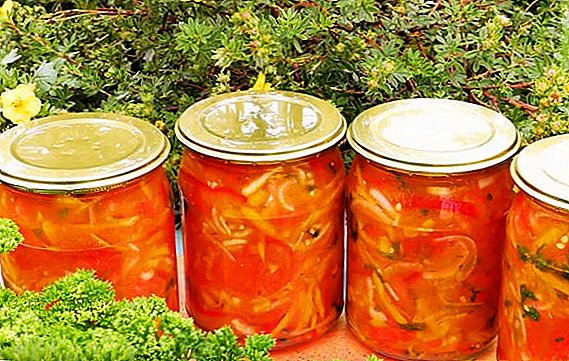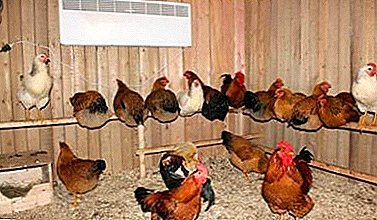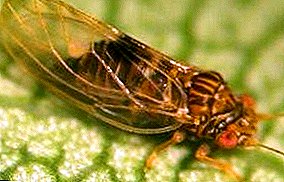
Medianits or listobloshki - are insect pests that pose a serious danger to orchards. They are small in size, but can jump to a very high altitude, which is why they became known as leaf beads.
This insect acquired its second name for the fact that its excretion of waste products look like small balls that cover sticky mass in the habitat.
There are many types of honeyfields, but the most common ones are apple and pear.
Pest description
Medianitsy distributed in the forest, steppe and forest-steppe zones of the country. The largest number is observed in the north-western regions of Russia.
Appearance
Adult pests have a length up to 3 mm. In the summer, they look bright; juicy colors dominate in color. green, red, Orange (depending on the species). In the fall and winter, insects acquire inconspicuous shades - dark brown, light yellow other.
Photo mednits:





The rear pair of legs is similar to those that have fleas - namely thanks to these limbs. Antennae long and thin. The wings are transparent, cover the body of the pest from above and from the sides.
The emergence of eggs carried at the end of winter, and the brawl begin to fly in the end of May. After 14 days they mate, then eggs appear. If the insect is an adult and has wintered, then it will fly in the first half of March, and makes laying at a temperature of +10 degrees.
Usually the clutch is from 20 to 90 eggs. Insect females live only for a month, but during this time in favorable conditions they set aside up to 600 eggs in spring and up to 1200 in summer.
Their size is small, in the process of maturation change color from whitish to light orange. Spring insects have eggs in the swelling buds, summer - on the back of the leaves. When a leaf or a branch dies off, the eggs also die.
The larvae that emerge from the eggs, lead a passive lifestyle, pass to fledging through 5 phases of development. Just hatched individuals live in the kidneys, and then, growing up, move to the branches themselves. Growing up, according to the conditions, can occupy from 15 to 60 days.
Medianits are sucking insects. After the larva has got out of the egg, it has been for a while is on the branch and breaking the bark drinking juice.
Then there is an introduction to the kidney, where the pest eats young leaves. When the greens appear on the trees, the larvae cling to the cuttings and stalks.
Listobloshki, depending on the species, affect a certain family of fruitful trees - apple trees, pears, plums, cherry plum, hawthorn and other. Insects living on willow, poplar tree, birch, maple, ash and other leafy rocks.
Signs of damage to the plant leaflets
 A tree attacked by an insect begins to turn yellow, its foliage falls. Damaged by the larvae of the buds do not bloom.
A tree attacked by an insect begins to turn yellow, its foliage falls. Damaged by the larvae of the buds do not bloom.
In addition, in the sticky fluid that the sheds emit, colonies of fungi begin to breed, for example, soot. Tree branches lose their immunity, cease to bear fruit, shrink in summer, in the winter - freezing.
If a flower damaged by the leafs is able to survive and pollinate, then the fruit of an atypical form with tasteless hard pulp grows from it.
IMPORTANT! The main sign of the appearance of the pest in the garden is the presence of sticky liquid on the leaves, branches and buds. It shines in the sun and over time covers both populated and non-populated parts of the tree.
Main types
In the world there is over 1300 species leaf beetles, of which about 300 are found on the territory of Russia. Some have become very famous for the large damage to fruit and berry crops.
Plum leafblock - attacks cherry plum and plum, causes damage and fall off of fruits and foliage. Adults have a length 2.3-2.8 mmthe front of the wings yellow brown, veins - reddish.
Winters on deciduous and coniferous trees, eggs lay in May. After mating, male and female fly away, and winter on different plants.
Hawthorn Leaflet - amazing apple tree, hawthorn, shishmulu. On the apple tree, the larvae settle in the buds and buds, preventing the development of leaflets and shoots. Females have a length up to 3.2 mmmales - up to 3 mm. The color varies depending on when the individual appeared.
Winter insects have a dark brown color., summer - yellow-green. Wintering takes place on a pine tree, then migration to a fruit plant takes place, where females can produce up to 400 eggs.
Carrot listobloshka - amazing planting carrots, parsley, parsnip. The adult insect is pale, its length reaches 1.5 mm.
Winter spends on coniferous treeswhere after waking it feeds. Then flies to the tops of carrots, where lays 100-200 eggs. By the fall back in the woods to the place of wintering.
Apple Copper
 Copper apple is most often found in places where apple trees are grown. Feeding on she emits sticky content globules with a wax coatwhich, decaying, glue buds, buds, clog the stoma flowers. Because of the damage received, the buds dry up and fall off, the leaves do not develop.
Copper apple is most often found in places where apple trees are grown. Feeding on she emits sticky content globules with a wax coatwhich, decaying, glue buds, buds, clog the stoma flowers. Because of the damage received, the buds dry up and fall off, the leaves do not develop.
Adult insects have a length of up to 2.5 mm. The head and chest are yellow-green, with reddish wings.
Only one generation of pest is produced per year.. Egg laying occurs in September-October, after which the adult individuals die. Hibernate on the bark. The release of the larvae coincides with the beginning of bud break on the apple trees, they climb there and attach to the petioles.
Development to adult takes 30-40 daysthat, after fledging, fly through the nearby gardens and trees. In September-October, all insects return to the apple trees for laying. Females can produce up to 180 eggs.
Pear Copper
 The pear leaflet is the most common type of pest that attacks pear trees.
The pear leaflet is the most common type of pest that attacks pear trees.
Adults, depending on time of appearance, may have orange-red color (summer) or dark brown (winter).
When the air temperature rises above +3 degrees, the pests wake up and begin to eat., and at +10 they can already lay eggs, about 1200 per generation.
In the southern regions of the country, the pear leaflet can display up to 5 generations per yearthat will overlap each other. 3-4 generations in the northern regions. Hot and dry weather favorably affects the rate of egg ripening and fecundity of females.
Methods of struggle
And yet how to deal with the sucker? In order to protect themselves from the leaflet in early spring, before the buds began to blossom, spraying needed of trees infusion of tobacco, yarrow, ashes or soap.
Destroy the eggsthat are already deposited on trees possible using nitrafena solution 3%.
If the time of release of the larvae of eggs has passedthen during the opening of the kidneys need to spray the shoots with a solution of the drug number 30 at a concentration of 2% or chemicalsthat are used to destroy aphids.
The best effect is achieved if the larvae are not covered with clods of honey dew.
Leaf droppers can be defused by fumigating with tobacco smoke.
For this:
- dry grass heaps are being prepared;
- tobacco waste is piled on top;
- then the garden is processed within 2-3 hours.
Listobloshka or sucker is a common insect pest that affects fruit trees. There are a large number of species that have received their name from the trees that serve them as food - apple, carrot, pear, etc.
Among them are insects that hibernate as adults and those who lay eggs in the fall. For pest control are used all sorts of insecticides and folk remedies.



